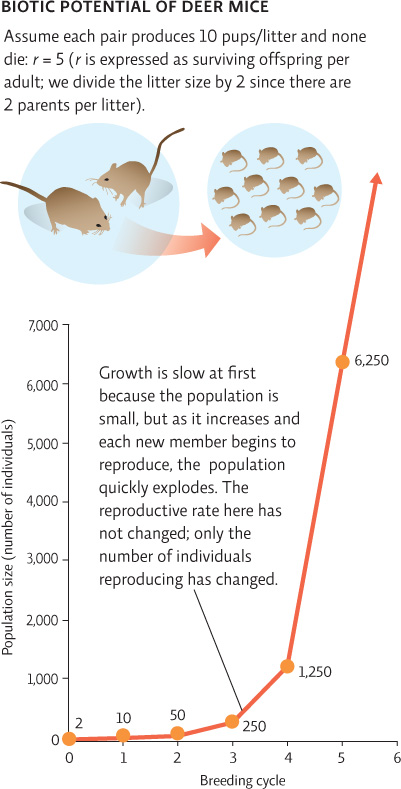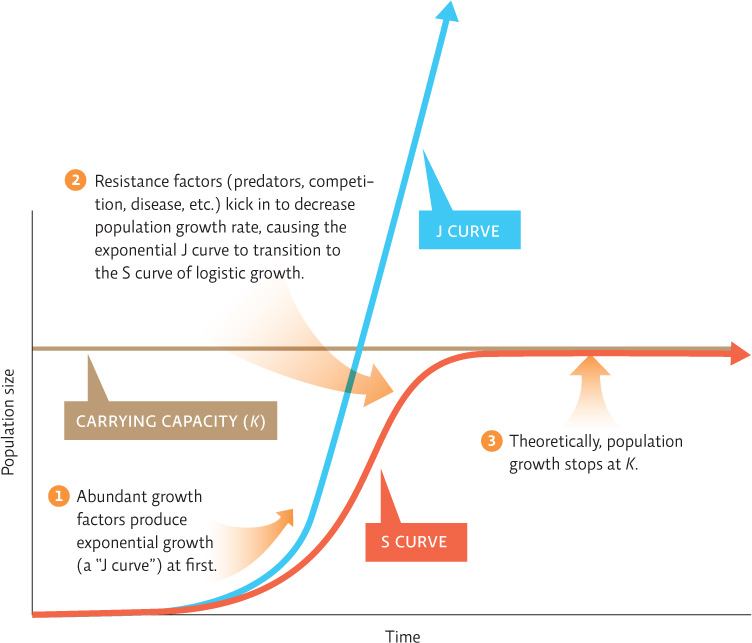Populations display various patterns of growth.
The researchers in the wolf restoration project could observe these factors—distribution, genetic diversity, initial population size, and density—as well as factors like prey availability and habitat structure and see how they influenced the size and dynamics of a population in Yellowstone. However, in order to predict population dynamics, scientists use some simple mathematical models that describe population growth over time. The annual population growth rate is determined by birth rate (for example, the number of births per 1,000 individuals per year) minus the population death rate (for example, number of deaths per 1,000 individuals per year) or by taking a simple census of population size at the two time points in question. For example, between 2009 and 2010, the wolf population went from 320 to 343, an increase of 23 animals. This is a growth rate of 7% (23/320 = 0.07). In that same time frame, the elk population decreased from 6,070 to 4,635, giving this population a negative growth rate (4,635 − 6,070 = −1, 435; −1,435/6,070= −0.24, or −24%).
population growth rate
The change in population size over time that takes into account the number of births and deaths as well as immigration and emigration numbers.
Population growth is dependent on the presence of growth factors (resources individuals need to survive or reproduce). Conversely, resistance factors (things that reduce population size by directly or indirectly killing individuals or prompting emigration), such as predators, competitors, or diseases, will decrease population size. When there are no environmental limits to survival or reproduction, a population will reach its maximum per capita rate of increase (r), called its biotic potential. This occurs, theoretically, when every female reproduces to her maximal potential and every offspring survives. A population increasing in this manner will quickly grow to fill its environment. This period of growth, which can’t go on indefinitely, is referred to as exponential growth, named for the mathematical function it represents.
growth factors
Resources individuals need to survive and reproduce that allow a population to grow in number.
resistance factors
Things that directly (predators, disease) or indirectly (competitors) reduce population size.
biotic potential (r)
The maximum rate at which the population can grow due to births if each member of the population survives and reproduces.
exponential growth
The kind of growth in which a population becomes progressively larger each breeding cycle; produces a J curve when plotted over time.
Populations that have a high biotic potential have high fecundity (females typically produce lots of offspring, reach reproductive maturity quickly, and produce many “clutches” per year). The higher the biotic potential, the faster the population of a given species will grow under ideal conditions. Yellowstone species such as deer mice and the problematic non-native weed known as spotted knapweed have higher biotic potential than species such as grizzly bears and spruce trees.
KEY CONCEPT 9.4
Both growth factors and resistance factors affect population growth. Exponential growth occurs when population growth is unrestricted, as might occur with the influx of a new food source or the removal of a major predator. However, exponential growth cannot continue indefinitely.
In nature, exponential growth is typically seen when a species first enters a new environment or when there is an influx of new resources. The population must have a high birthrate—most individuals must have access to enough food, water, and habitat in which to reproduce—and a low death rate. The loss of predators can also lead to exponential growth among their prey species. For instance, without wolves to thin their ranks, elk numbers in Yellowstone doubled between 1914 and 1932, after the Predator Control Program had been implemented. This led to the need to cull the herd (in spite of increased hunting pressure), a standard practice for many years that reduced the herd from 16,000 in 1932 to around 6,000 in 1968, when this practice ended; elk population sizes climbed to a high of around 19,000 in the 1980s before wolves were reintroduced.
A population that is growing exponentially will have a J-shaped curve if plotted on a graph with time on the x-axis and population size on the y-axis. The J curve shows a slight lag at first and then a rapid increase. This is due to the fact that the larger the population, the faster it grows, even at the same growth rate. Think of it this way: Doubling a small number yields a number that is still small. Doubling a large number, on the other hand, produces a very large number. INFOGRAPHIC 9.2
Because deer mice have a high biotic potential, even a single pair could produce more than 31,000 descendants in their lifetime.


Cockroaches thrive in some homes and apartments. What could trigger exponential growth in a cockroach population? What could prevent it?
Exponential growth would be triggered by the presence of food; keeping the home and kitchen clean, properly stowing food garbage can remove the roach's food supply.
As an example of how profound exponential growth can be, imagine if someone offered to give you a penny one day and then, each subsequent day for a month, doubled the amount given to you the previous day. On day 1 you would have 1 cent; on day 2 you would be given 2 cents; on day 3 you’d be given 4 cents, and on day 4, you would be given 8 cents. By day 31, you would have more than $21 million. Exponential growth can create large populations quickly.
Exponential growth can’t last forever, however; as a population begins to fill its environment, its growth rate decreases because as more individuals use the available resources, the resources become scarce. Some individuals starve or are unable to find habitat in which to reproduce, and crowding may also bring about an increase in disease and aggression. Predation pressure may increase as the more numerous prey is easier to track and capture or simply because the predator population itself has increased. This kind of growth—in which as population size increases, growth rate decreases—is called logistic growth.
logistic growth
The kind of growth in which population size increases rapidly at first but then slows down as the population becomes larger; produces an S curve when plotted over time.
KEY CONCEPT 9.5
As a population’s size approaches carrying capacity, exponential growth may transition to logistic growth, slowing population growth rates.
A population that grows logistically will produce an S-shaped curve if plotted on a graph with time on the x-axis and population size on the y-axis. The S is created by the initial growth of the J-shaped curve of exponential growth, followed by decelerating growth as the species approaches its maximum sustainable population size, where it levels off.
The population size that a particular environment can support indefinitely—without long-term damage to the environment—is called its carrying capacity, signified as K in population mathematical models. Carrying capacity is determined by the presence of growth factors and varies between species; the same environment can support many more elk than wolves, for example. Over time, a population’s carrying capacity can change. If resources are diminished at a faster rate than they are replenished, the carrying capacity will drop. If, on the other hand, new resources are added or become available, perhaps due to the loss of a competitor, the carrying capacity for a given species will rise. INFOGRAPHIC 9.3
carrying capacity(K)
maximum population size that a particular environment can support indefinitely.
Exponential growth turns into logistic growth (S curve) as population size approaches carrying capacity (K) and resistance factors begin to limit survival.


What could increase or decrease the carrying capacity for a particular population in an environment?
The arrival of new resources or loss of a competitor for growth factors could increase K. Things that decrease growth factors available to the population could decrease K, such as: the depletion of food supplies, habitat disruption, or arrival of a competitor for growth factors.